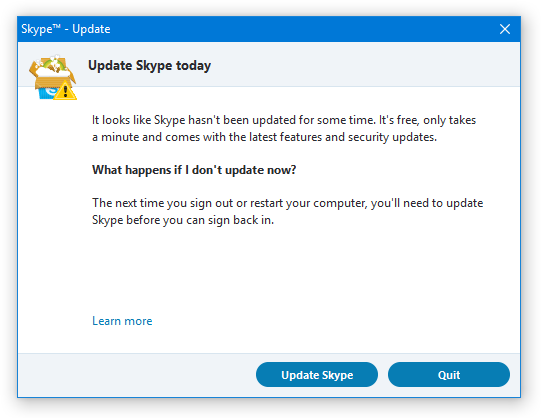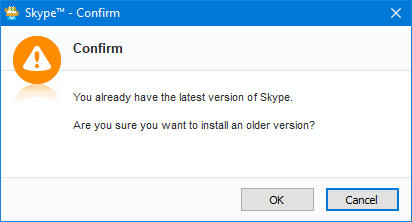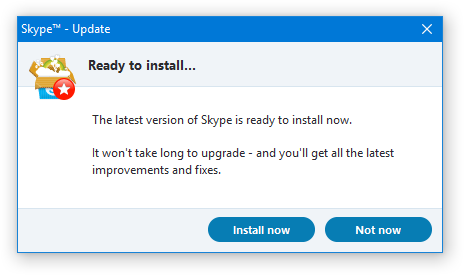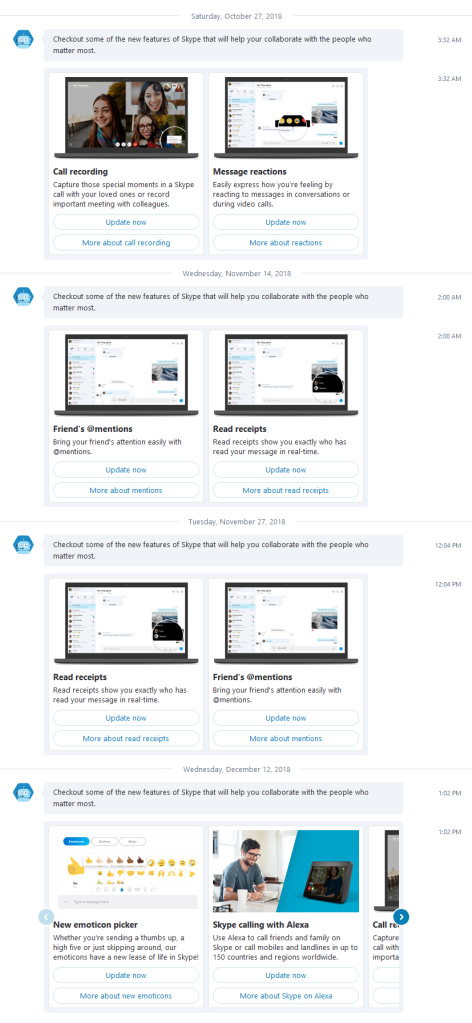Skype 7 blocked from signing in but you can still use older versions
EDIT Jan 16 2019: The 7.40 version stopped working for me today, but downgrading to 7.36 restored the ability to sign in. I’ve updated the article accordingly.
Coinciding with Update “Patch” Tuesday on January 8th, the latest version of Skype “Classic” 7 is no longer allowing users to sign in and instead prompts you to update:

“It looks like Skype hasn’t been updated for some time. It’s free, only takes a minute and comes with the latest features and security updates.”
Despite the “What happens if I don’t update now?” and “The next time you sign out or restart your computer” verbiage, I’ve only seen the message pop up after you’ve been signed out or if you try to sign in on a computer that’s been offline.
How to keep using Skype 7
Strangely enough, instead of utilizing their prior version-pushing capabilities, only the last version of Skype 7 seems to contain the code to show the above forced upgrade message and using a previous version of Skype 7 will still allow you to sign in.
To continue using Skype 7, download and install the 7.36 version (7.36.0.101). When the confirmation prompt appears, choose OK to install the older version.

Skype should operate just as before. One small caveat I have noticed on PCs that do not have Skype already installed previously, the username and password are not being saved and Skype prompts for credentials on every sign in.
Additionally, to avoid upgrade prompts, it appears copying the installer in your profile’s temp folder (Open up Start, type %localappdata%\temp and press Enter to get there), rename the file to SkypeSetup (so technically SkypeSetup.exe) and then right-click, select Properties and set the file to read only.
How long the older versions will continue to work is anyone’s guess, but my prediction is Skype will watch as people are slowly forced off the old version until the user population of 7 is low enough to pull the plug on the servers/protocol version.
The battle for Skype 7
Just to step back a minute, this is not an unplanned or surprising event. Back in September, Skype claimed that they would be ending support for Skype Classic on the desktop on November 1st and for mobile platforms, on the 15th. This never happened and we moved into the new year with Skype Classic still operating normally.
And that wasn’t the first announcement either, back in July it was announced they would end support on September 1st, which then was subsequently changed in August to “extended support for some time”.
They’ve also been prodding users with upgrade messages and tidbits on their new features of the latest version for many months:

My primary reasons for sticking with Skype 7 are the integration with my headset’s buttons and LED indicators, easy access to my 13 years of message history, and the many benefits of using a real, non-web based application.
The end of MSN Protocol (MSNP)
Back in August, Bruce Lowekamp, Principal Architect for Skype’s Cloud Infrastructure, did a fascinating talk on “Skype’s Journey from P2P” which among other great information, was littered with small details on Skype’s past and current infrastructure. I made some detailed notes of the entire presentation, but it was mentioned that Skype moved from Messenger’s protocol to “New Chat Service”. Although I have no evidence of this at present, I would imagine the Messenger protocol is what is to be removed once Skype 7 no longer works in any form, and thus marking the final end of the Messenger protocol.
Upgrade paths and other options
There are a few options available when Skype 7 will no longer work:
- The official upgrade path, Skype 8, is an electron/web-based application, and thereby uses quite a lot of memory, generally is weak on performance and as far as I am aware of presently, message history is stored “on the cloud” for two years only.
- The built-in Windows 10 Skype UWP version uses far less memory, far less CPU and power, and still does still save to a local database format which appears to be exportable using anything that can read SQLite 3 databases.
- EionRobb’s regularly maintained SkypeWeb for libpurple-enabled clients (Pidgin, Bitlbee, and others) allows use of Skype using a third-party client. However, voice/video calls are not yet supported.
I plan on trying the UWP version full-time if/when Skype 7 becomes unusable as it seems like the best option, especially when my usage of Skype is primarily for voice calls.
A special thanks to my friend Nojus for discovering that prior versions of Skype 7 were still working.
Posted on January 10, 2019, in Messenger, MSN Messenger, Skype. Bookmark the permalink. 9 Comments.

The way the companies have created so many Live Messenger-like programs and apps it’s nearly impossible to gather people under one program. Uninstalled Skype from my Win7 desktop and Win10 laptop since no one I know is using it. Our so-called techno wizards have done a great job of sending us backwards with live communication software. Here’s a good one for you – coming soon people will no longer be able to share a video, from YouTube, with Facebook and Twitter.
Hi Jonathan, I tried to download Skype 7.36 with the links you provided, but it says ‘failed – no file’ and the link itself is dead.
Hey Sarah – it’s working fine for me here and I have other things hosted on that machine that are operating fine, perhaps you might want to try a different browser?
So I’ve had some trouble with 7.36 today. Installing it brought me directly to an upgrade page on my laptop. It’s still working fine on my desktop, so I copied the skype directory from Program Files (x86) and overwrote the one on my laptop. It ran, but almost immediately presented me with the upgrade message. So I overwrote it again, ran it, and immediately went into Skype Options before the message appeared. The message still appeared, but because I was in options I could close the message without Skype closing.
I have since replaced SkypeSetup.exe in appdata/local/temp with a dummy file and removed System’s permissions to modify or run it.
Probably won’t last, but that’s at least five more minutes of classic Skype, and counting.
I saw this mentioned elsewhere last week and have been testing it to see if it made any difference. It does appear it does, although I didn’t go as far to change the permissions and just set it to read only.
It appears that most of what I described is unnecessary, so long as you have enough time to get into Skype options. (Fastest way I know of being alt, then t, then o, as three separate keypresses and not a combination. Once you’re in options, you can dismiss the message safely.
I haven’t had an issue since. I’m not sure if that’s any of the other steps I took or not.
Apparently, Skype 5.5 (somewhat) works.
Skype is awesome. My family has been using it for years and years to communicate with each other. We are scattered across the states and even have a third of the family pie population in Switzerland. The timing can get a bit crazy but we make it work. There is even software for photo and video sharing. I love living in this day and age!
bonjour, c’est a cause de personne comme vous que l’on a perdu windows live messenger, enciennement MSN Messenger.